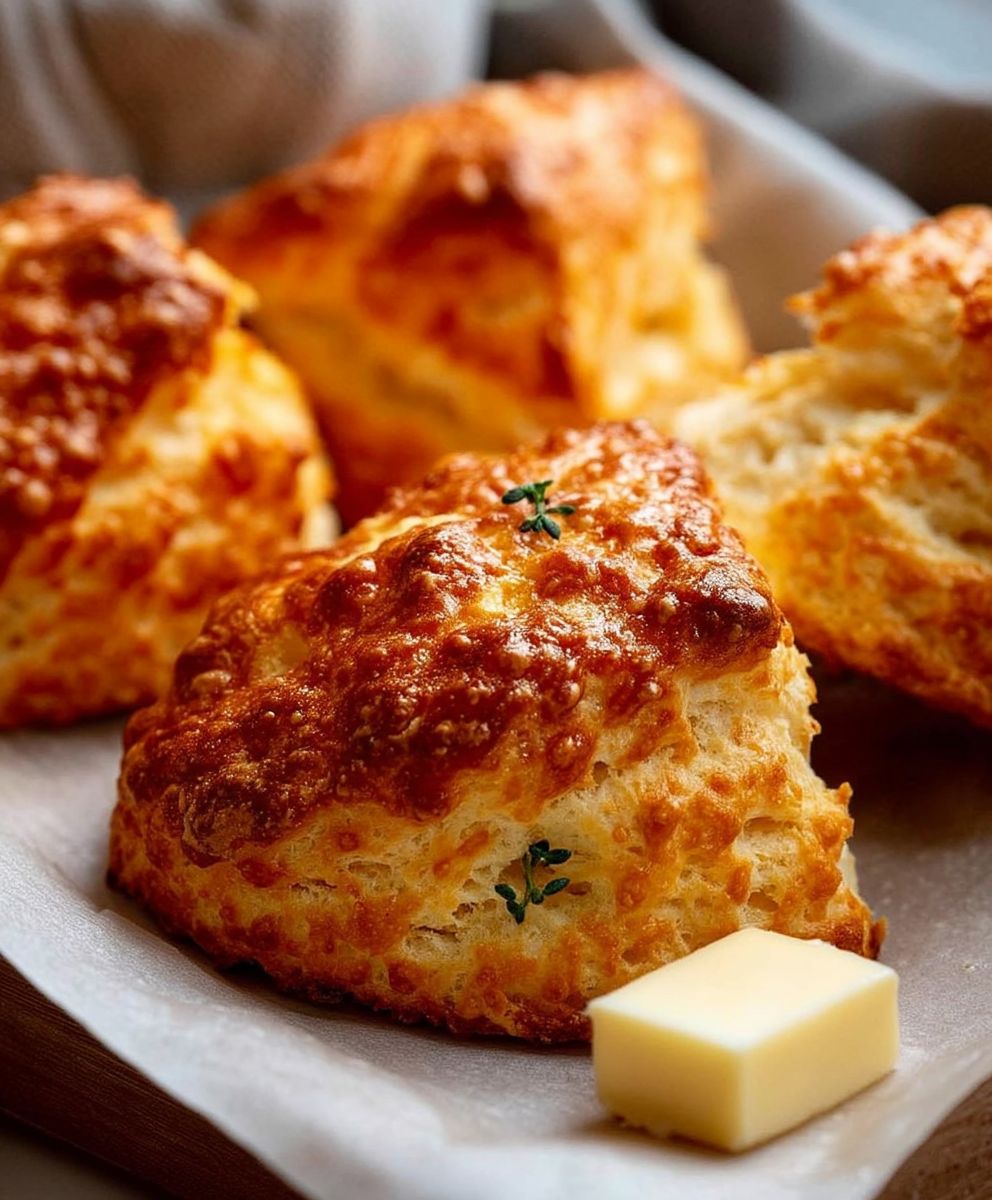Cheese scones, those savory delights that straddle the line between bread and biscuit, are a true testament to the magic of simple ingredients. Have you ever craved something warm, comforting, and utterly satisfying, all in a single bite? Then look no further! These golden-brown beauties, fresh from the oven, are the answer to your culinary prayers.
While the exact origins of the scone are debated, with some tracing them back to Scotland and others to England, one thing is certain: they’ve been a beloved staple for centuries. Originally baked on a griddle over an open fire, scones have evolved into a versatile treat enjoyed around the world. The addition of cheese elevates the humble scone to a whole new level of deliciousness.
What makes cheese scones so irresistible? It’s the perfect combination of textures a slightly crisp exterior giving way to a soft, fluffy interior. The savory cheese, often cheddar or a similar variety, adds a depth of flavor that’s both comforting and addictive. They’re incredibly easy to make, requiring minimal ingredients and effort, making them perfect for a quick breakfast, a light lunch, or a delightful afternoon tea. Plus, the aroma that fills your kitchen as they bake is simply divine! Get ready to experience the joy of homemade cheese scones you won’t be disappointed.
Ingredients:
- 225g self-raising flour, plus extra for dusting
- 1 tsp baking powder
- 50g cold butter, cut into cubes
- 150g mature cheddar, grated
- 150ml milk
- Pinch of salt
- 1 tbsp milk, for glazing
Preparing the Dough:
- First things first, preheat your oven to 220°C (200°C fan/Gas Mark 7). Make sure your oven is nice and hot this is key to getting that lovely rise on your scones. Line a baking tray with baking parchment. This will prevent the scones from sticking and make cleanup a breeze.
- Now, let’s get started on the dry ingredients. In a large mixing bowl, sift together the 225g of self-raising flour and 1 teaspoon of baking powder. Sifting is important because it helps to aerate the flour, which will result in lighter and fluffier scones. Don’t skip this step! Add a pinch of salt to enhance the flavors.
- Next, add the 50g of cold, cubed butter to the flour mixture. The butter needs to be cold, as this will help create pockets of air in the dough, leading to a flaky texture. Use your fingertips to rub the butter into the flour until the mixture resembles breadcrumbs. You can also use a pastry blender or a food processor for this step, but I find that using my fingertips gives me the best control. Make sure there are no large lumps of butter remaining.
- Add 125g of the grated mature cheddar cheese to the bowl, reserving the remaining 25g for topping. Mix well to ensure the cheese is evenly distributed throughout the flour and butter mixture. The cheese adds a wonderful savory flavor to the scones, and using a good quality mature cheddar will make all the difference.
- Gradually add the 150ml of milk to the bowl, mixing with a round-bladed knife until a soft dough forms. Be careful not to overmix the dough, as this will develop the gluten and result in tough scones. The dough should be slightly sticky, but not too wet. If the dough is too dry, add a little more milk, a teaspoon at a time, until it comes together. If it’s too wet, add a little more flour.
- Turn the dough out onto a lightly floured surface. Gently pat the dough into a round about 2-3cm thick. Again, be careful not to overwork the dough. The less you handle it, the lighter your scones will be.
Cutting and Baking:
- Using a 5cm round cutter, cut out the scones from the dough. Try to avoid twisting the cutter, as this can seal the edges and prevent the scones from rising properly. If you don’t have a round cutter, you can use a sharp knife to cut the dough into squares or triangles.
- Place the scones onto the prepared baking tray, leaving a little space between each one. This will allow the hot air to circulate and ensure that the scones bake evenly.
- Brush the tops of the scones with the remaining 1 tablespoon of milk. This will give them a lovely golden-brown color. You can also use a beaten egg for a richer glaze, but milk works just fine.
- Sprinkle the reserved 25g of grated cheddar cheese over the tops of the scones. This adds a final touch of cheesy goodness and makes them look even more appealing.
- Bake in the preheated oven for 12-15 minutes, or until the scones are golden brown and well-risen. Keep an eye on them, as oven temperatures can vary. They should be firm to the touch and sound hollow when tapped on the bottom.
- Once baked, transfer the scones to a wire rack to cool slightly. They are best served warm, with butter or your favorite spread.
Tips and Variations:
- For extra flavor, try adding a pinch of mustard powder or a few chopped chives to the dough.
- If you don’t have self-raising flour, you can use plain flour and add 2 teaspoons of baking powder.
- To make ahead, you can prepare the dough up to the point of cutting out the scones. Wrap the dough tightly in cling film and store it in the refrigerator for up to 24 hours. When ready to bake, cut out the scones and bake as directed.
- For a sweeter scone, add a tablespoon of sugar to the dry ingredients. You can also add dried fruit, such as raisins or sultanas.
- To freeze baked scones, allow them to cool completely before wrapping them individually in cling film and placing them in a freezer bag. They can be stored in the freezer for up to 3 months. To reheat, bake them in a preheated oven at 180°C (160°C fan/Gas Mark 4) for 10-15 minutes, or until warmed through.
- Don’t overmix the dough! This is the most important tip for making light and fluffy scones. Overmixing develops the gluten in the flour, which can result in tough scones. Mix the dough just until it comes together, and then stop.
- Use cold butter! Cold butter helps to create pockets of air in the dough, which will result in a flaky texture. Make sure the butter is cold before you start rubbing it into the flour.
- Handle the dough gently! The less you handle the dough, the lighter your scones will be. Avoid kneading the dough, and gently pat it into a round before cutting out the scones.
- Bake the scones in a hot oven! A hot oven is essential for getting that lovely rise on your scones. Make sure your oven is preheated to the correct temperature before you start baking.
- Don’t overcrowd the baking tray! Leave a little space between each scone on the baking tray. This will allow the hot air to circulate and ensure that the scones bake evenly.
Serving Suggestions:
These cheese scones are delicious served warm with butter, cream cheese, or your favorite savory spread. They are also great with soup or as a side dish to a salad. For a special treat, try serving them with a dollop of chutney or a slice of ham.
Storage Instructions:
Store leftover scones in an airtight container at room temperature for up to 2 days. To refresh them, warm them in a preheated oven at 180°C (160°C fan/Gas Mark 4) for a few minutes.
Nutritional Information (per scone, approximate):
Calories: 250-300
Fat: 15-20g
Protein: 8-10g
Carbohydrates: 25-30g
Enjoy your homemade cheese scones!

Conclusion:
Well, there you have it! I truly believe this cheese scone recipe is an absolute must-try. From the incredibly light and fluffy texture to the sharp, savory cheese flavor that bursts in your mouth with every bite, these scones are a game-changer. They’re so much more than just a quick bread; they’re an experience! And honestly, who can resist a warm, cheesy scone fresh from the oven?
Why are these scones so special? It’s the perfect balance of simplicity and flavor. The ingredients are readily available, the method is straightforward, and the result is simply divine. Forget those dry, crumbly scones you might have encountered before. This recipe delivers consistently moist, tender scones that will impress even the most discerning palates.
But the best part? These cheese scones are incredibly versatile! They’re fantastic on their own, warm from the oven with a generous slather of butter. But don’t stop there!
Serving Suggestions:
* For Breakfast or Brunch: Serve them alongside scrambled eggs, crispy bacon, and a dollop of your favorite jam. The savory cheese complements the sweetness of the jam beautifully.
* For Lunch: These scones make a wonderful accompaniment to a hearty soup or a fresh salad. Imagine a warm cheese scone paired with a creamy tomato soup on a chilly day pure comfort food!
* For Afternoon Tea: Elevate your afternoon tea with these delightful scones. Serve them with clotted cream and a selection of preserves for a truly indulgent treat.
* As a Snack: Need a quick and satisfying snack? A cheese scone is the perfect solution. They’re filling, flavorful, and oh-so-delicious.
Variations to Explore:
* Herb Infusion: Add a tablespoon of chopped fresh herbs like rosemary, thyme, or chives to the dough for an extra layer of flavor.
* Spicy Kick: Incorporate a pinch of cayenne pepper or some finely chopped jalapeños for a touch of heat.
* Different Cheeses: Experiment with different types of cheese! Try using cheddar, Gruyere, or even a blue cheese for a unique flavor profile. A combination of cheeses can also work wonders.
* Sweet and Savory: Add a handful of dried cranberries or chopped dates for a sweet and savory twist.
* Garlic Goodness: A teaspoon of garlic powder can add a savory depth that complements the cheese perfectly.
I’m so excited for you to try this recipe and discover the joy of homemade cheese scones. I know you’ll love them as much as I do! The aroma that fills your kitchen as they bake is simply intoxicating, and the first bite is pure bliss.
So, what are you waiting for? Gather your ingredients, preheat your oven, and get ready to bake some seriously delicious cheese scones. I promise you won’t regret it!
And most importantly, I’d love to hear about your experience! Did you try any of the variations? What did you serve them with? Share your photos and stories in the comments below. Let’s spread the love of these amazing scones and inspire others to get baking! Happy baking, and enjoy every cheesy, fluffy bite! I can’t wait to see your creations!
Cheese Scones: The Ultimate Guide to Baking Perfect Savory Scones
Fluffy, savory cheese scones, best served warm. Quick to make and full of mature cheddar flavor.
Ingredients
- 225g self-raising flour, plus extra for dusting
- 1 tsp baking powder
- 50g cold butter, cut into cubes
- 150g mature cheddar, grated
- 150ml milk
- Pinch of salt
- 1 tbsp milk, for glazing
Instructions
- Preheat oven to 425°F (220°C). Line a baking tray with parchment paper.
- Sift together flour and baking powder in a large bowl. Add salt.
- Rub cold butter into the flour mixture until it resembles breadcrumbs.
- Add 125g of the grated cheddar cheese to the bowl, reserving the remaining 25g for topping. Mix well.
- Gradually add milk, mixing with a round-bladed knife until a soft dough forms. Be careful not to overmix.
- Turn dough out onto a lightly floured surface. Gently pat into a 2-3cm thick round.
- Use a 5cm round cutter to cut out scones. Avoid twisting the cutter.
- Place scones on the prepared baking tray, leaving space between each.
- Brush the tops of the scones with the remaining milk.
- Sprinkle the reserved cheddar cheese over the tops of the scones.
- Bake for 12-15 minutes, or until golden brown and well-risen.
- Transfer to a wire rack to cool slightly. Serve warm.
Notes
- For extra flavor, add a pinch of mustard powder or chopped chives to the dough.
- If you don’t have self-raising flour, use plain flour and add 2 teaspoons of baking powder.
- To make ahead, prepare the dough up to the point of cutting out the scones. Wrap the dough tightly in cling film and store it in the refrigerator for up to 24 hours. When ready to bake, cut out the scones and bake as directed.
- For a sweeter scone, add a tablespoon of sugar to the dry ingredients. You can also add dried fruit, such as raisins or sultanas.
- To freeze baked scones, allow them to cool completely before wrapping them individually in cling film and placing them in a freezer bag. They can be stored in the freezer for up to 3 months. To reheat, bake them in a preheated oven at 350°F (180°C) for 10-15 minutes, or until warmed through.
- Don’t overmix the dough! This is the most important tip for making light and fluffy scones. Overmixing develops the gluten in the flour, which can result in tough scones. Mix the dough just until it comes together, and then stop.
- Use cold butter! Cold butter helps to create pockets of air in the dough, which will result in a flaky texture. Make sure the butter is cold before you start rubbing it into the flour.
- Handle the dough gently! The less you handle the dough, the lighter your scones will be. Avoid kneading the dough, and gently pat it into a round before cutting out the scones.
- Bake the scones in a hot oven! A hot oven is essential for getting that lovely rise on your scones. Make sure your oven is preheated to the correct temperature before you start baking.
- Don’t overcrowd the baking tray! Leave a little space between each scone on the baking tray. This will allow the hot air to circulate and ensure that the scones bake evenly.





Leave a Comment